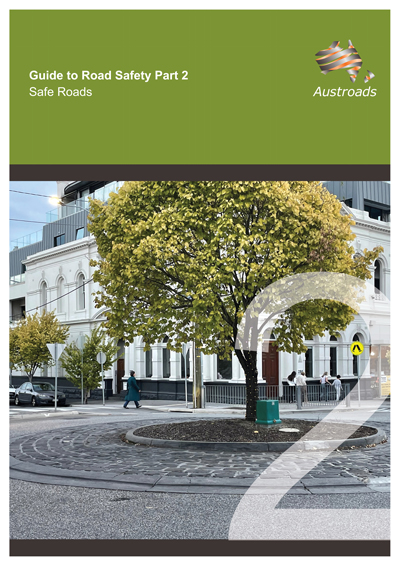Road Safety

- Publication no: AGRS02-24
- ISBN: 978-1-922994-30-1
- Published: 1 July 2024
- Edition: 2.0
- PDF (free) Download
Austroads' Guide to Road Safety has been developed to provide an overview of road safety and road safety practices in Australia and New Zealand.
Guide to Road Safety Part 2: Safe Roads is designed to provide all levels of government in jurisdictions across Australia and New Zealand with information on the role infrastructure plays in the Safe System and guidance on the selection and implementation of infrastructure treatments to reduce road trauma and deliver a zero-harm future.
These guidelines cover network risk assessment techniques and present a suite of infrastructure interventions (proven and emerging) that can be implemented to address the key road safety issues on our road networks: high-speed lane departures, intersections, and vulnerable road users. Interventions are categorised using a treatment hierarchy approach aligned with Safe System principles.
This Guide contains practical, hands-on advice to help practitioners identify, prioritise, and deliver infrastructure interventions that are aligned with Safe System principles and the contemporary Zero Planning approach to road safety.
This Guide should be read in conjunction with all other parts of the AGRS.
- 1. Introduction
- 1.1 Purpose of this Guide
- 2. The Role of Infrastructure in a Zero-Harm Future
- 2.1 The Zero Planning approach
- 2.2 The Safe System approach
- 2.2.1 How are things different under a Safe System?
- 2.3 How infrastructure influences safety outcomes
- 2.3.1 Safe System boundary conditions
- 2.3.2 Approaches to improving road safety with infrastructure
- 3. Risk Identification and Analysis
- 3.1 Understanding the road safety problem
- 3.2 Key crash types
- 3.3 Network analysis
- 3.3.1 Reactive approaches
- 3.3.2 Proactive approaches
- 3.3.3 Systemic approaches
- 4. Hierarchy of Treatment for Infrastructure Interventions
- 4.1 Primary treatments
- 4.2 Supporting treatments – stepping towards Safe System
- 4.3 Supporting treatments – other
- 4.4 Non-Safe System treatments
- 4.5 Implementation approach
- 5. Addressing High-Speed Lane Departures
- 5.1 What do we know?
- 5.1.1 Head-on crashes
- 5.1.2 Road departure crashes
- 5.2 Treatment hierarchy
- 5.3 Primary treatments
- 5.4 Supporting treatment – step towards: head-on crash risk
- 5.4.1 Median (central) barrier
- 5.4.2 Wide centreline
- 5.5 Supporting Treatments – Step Towards: Roadway Departure Crash Risk
- 5.5.1 Roadside barrier
- 5.5.2 Clear zones
- 5.6 Supporting treatments – other
- 5.1 What do we know?
- 6. Addressing Intersection Safety
- 6.1 What do we know?
- 6.1.1 Determinants of injury at intersections
- 6.2 Treatment hierarchy
- 6.3 Primary treatments
- 6.3.1 Grade separation
- 6.3.2 Roundabouts
- 6.3.3 Raised safety platforms
- 6.4 Supporting treatments – step towards
- 6.4.1 Banning selected movements
- 6.4.2 Intersection speed zones
- 6.5 Supporting treatments – other
- 7. Addressing Pedestrian, Cycle and Motorcycle Safety
- 7.1 Facts and actions to improve safety for walking and cycling
- 7.1.1 Pedestrians
- 7.1.2 Cyclists
- 7.1.3 Treatments for pedestrians and cyclists
- 7.2 Facts and actions to improve safety for motorcycling
- 7.2.1 Treatments for motorcyclists
- 7.2.2 Barriers and motorcyclists
- 7.1 Facts and actions to improve safety for walking and cycling
- 8. Estimating Benefits of Infrastructure Treatments
- 8.1 Establishing baseline safety performance
- 8.2 Determining benefits
- 8.2.1 Crash modification factors
- 8.2.2 Multiple treatments
- 8.2.3 Proactive evaluation
- 8.3 Economic appraisal
- 8.3.1 Benefit-cost analysis
- 8.3.2 Cost-effectiveness analysis
- 9. Approaches to Developing Infrastructure Programs
- 9.1 Top-down and bottom-up approaches
- 9.2 Safety performance indicators (SPI) approach
- 9.3 The goals achievement approach
- 9.4 Economic approaches
- 9.5 Network safety plan approach
- 10. Design and Implementation of Infrastructure
- 10.1 Safe System assessment
- 10.2 Road safety audit
- 10.3 Safe System audits
- 11. Monitoring and Evaluation
- 11.1 Monitoring and evaluation methods
- 11.1.1 Statistical analysis
- 11.2 Issues for consideration
- 11.2.1 Plan for monitoring at the outset
- 11.2.2 Threats to the validity of evaluation
- 11.1 Monitoring and evaluation methods
- References
- Appendix A Limitations and Accuracy of Crash Data
- Appendix B Safe System Aligned Measures for Pedestrians and Cyclists
- B.1 At intersections
- B.1.1 Roundabouts with wombat crossing
- B.1.2 Threshold platforms
- B.1.3 All-way stop signs
- B.1.4 Signalised intersections with ‘scramble’ phasing and 30 km/h (or lower) speed limits
- B.1.5 Restricted access
- B.1.6 Geo-fencing technology on public transport vehicles
- B.1.7 Raised signalised intersections with 30 km/h (or lower) ramps
- B.1.8 Signalised intersections with 30 km/h (or lower) platforms
- B.1.9 Raised intersections with 10 km/h or 20 km/h ramps
- B.1.10 Protected cyclist intersections
- B.1.11 Signalised ‘tennis ball’ intersections with 30 km/h geometry (or lower)
- B.1.12 Signalised roundabout with separate phases for public transport, cyclists and pedestrians
- B.1.13 Grade separation
- B.2 Between intersections
- B.2.1 Footpaths
- B.2.2 30 km/h (or lower) speed limits
- B.2.3 Shared use by cyclists of general traffic lanes (with 30 km/h speed limit or lower)
- B.2.4 Playground zones
- B.2.5 Limiting access by mode
- B.2.6 On-road cycle lanes (30 km/h speed limit or lower)
- B.2.7 Wombat crossings (30 km/h or lower platforms)
- B.2.8 Zebra crossings (with 30 km/h speed limits or lower)
- B.2.9 Kerb blisters or road narrowing
- B.2.10 Speed platforms
- B.2.11 Horizontal deflection
- B.2.12 Road narrowing
- B.2.13 Textured or coloured road pavements
- B.2.14 Shared zones
- B.2.15 Fully segregated pedestrian paths
- B.2.16 Separated cycle facilities
- B.2.17 Pedestrian-operated signals, zebras and wombats in 30 km/h (or lower) speed limits
- B.2.18 Car-free streets
- B.2.19 Exposure reduction or redirection of through-traffic
- B.2.20 Medians
- B.2.21 Relocation of tram stops (from the centre of road to the roadside)
- B.2.22 Pedestrian malls
- B.2.23 Grade-separation of pedestrians and cyclists from vehicular traffic
- B.1 At intersections
